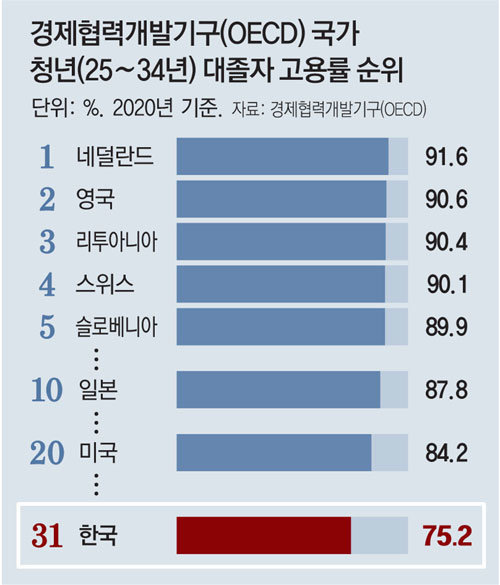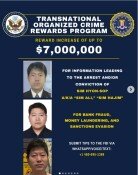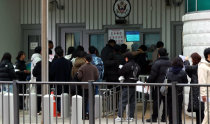Youth employment rate in S. Korea lagging at 75.2%
Youth employment rate in S. Korea lagging at 75.2%
Posted November. 19, 2021 07:22,
Updated November. 19, 2021 07:22

Research found that the employment rate of South Korean youth with the academic background of a junior college degree or higher is ranked 31st out of the 37 members of the OECD. Owing to a “mismatch” between the major of graduates and the actual job opportunities in labor market is causing a prolonged preparation for job searching or idling the youth. Another factor at play is the sluggish job market for those with higher educational background owing to the economic doldrums.
According to an analysis conducted by the Korea Economic Research Institute (KERI) under the Federation of Korean Industries, the youth employment rate in South Korea among those aged 25 to 34 with college education stood at 75.2%, lower than the OECD average (82.9%).
The primary reason can be found in the abundance of economically inactive population in the country. The share of economically inactive population in South Korea is 20.3%, the third highest following Italy (24.9%) and the Czech Republic (21.7%). Last year, among every 10 economically inactive youth in South Korea, three said they were preparing to land a job, and two said they were just taking a break.
The discrepancy between what the graduates majored in college and the actual job positions available to them is fueling the prolongation of preparation. According to an OECD data, the mismatch rate in Korean labor market is 50.2%, the highest among the 22 surveyed OECD member states. A survey conducted this year by Statistics Korea found the mismatch rate to be 52.3%, suggesting more than half of the working population is in a position that has nothing to do with what they studied at college.
“The quota at the Computer Science Dept. at Stanford University jumped fivefold from 141 in 2008 to 745 in 2020 while the maximum number of students admitted in the Seoul National University’s computer science department only made a piecemeal growth from 55 to 70,” said Kim Yong-chun, Head of Employment Policy Team at the KERI. “The capacity of college departments needs to expand along the shifting structure of industry, but under the restriction over the number of students allowed, colleges are struggling to revamp their fundamentals.”
From 2013 to 2020, the number of college graduates rose by 3.0% every year, but the job opportunities for higher academic credentials grew at a snail’s pace of 1.3% a year. The KERI suggested that the number of jobs available for the youth might plummet by 346,000 in three years owing to the shifting industrial structure and economic downturn.
Hyun-Seok Lim lhs@donga.com





![교육부 장관인가, 교사부 장관인가[오늘과 내일/우경임]](https://dimg.donga.com/c/138/175/90/1/wps/NEWS/IMAGE/2025/12/26/133045801.1.png)

